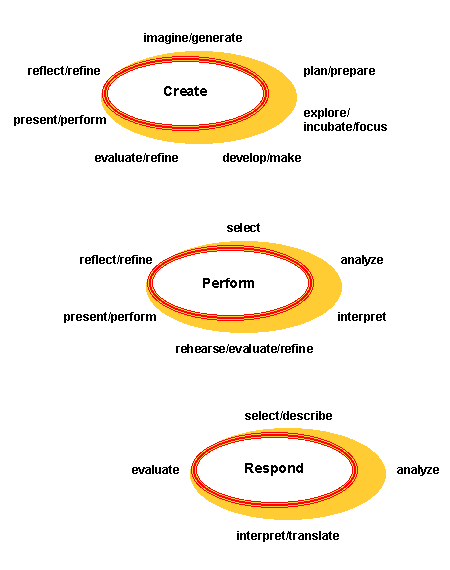

Content standards are clearly defined expectations by which individual student achievement and progress may be judged. They outline what a student needs to know and do in a particular subject. Students demonstrate their knowledge of content through assessment tasks. Teachers use large processes and concepts to further guide curriculum and instruction. This page contains information about:
A student shall describe at least three of the art forms in this subpart using the vocabulary of the art form and identifying similarities and differences between different art forms. A student shall:
|
in dance, demonstrate basic movements in musical or rhythmic contexts, respond to selected assignments and problems, and create sequences of movement to communicate an original story or an experience; |
|
in visual art, use appropriate tools and processes of at least three different media to communicate ideas, use elements of visual art to communicate ideas, and identify works and styles of art belonging to different cultures and times; |
|
in music, sing in a group, sing a varied repertoire of songs, play simple rhythms and melodies on classroom instruments, improvise simple rhythms and melodies, and use a system to read basic music notation; |
|
in theater, use movement, sound, and language to create images, express emotions, and imitate animals, objects, or shapes; and use elements of environment, costume, and props to communicate story and character. |
A student shall create, interpret, and evaluate the elements and principles of at least three of the art forms in this subpart. A student shall:
|
in dance, demonstrate characteristic dance styles from more than one form or tradition; observe and discuss how dances are similar in terms of elements of dance; demonstrate more than one solution for creative movement problems; and use basic movements to create and perform a sequence with a beginning, middle, and end, with or without music; | |
|
in visual arts, demonstrate the ability to communicate ideas effectively through at least three different media and techniques, use elements and principles of art to effectively communicate ideas, associate artwork with various cultures or historical periods, and describe selected works of art in terms of the elements and principles of visual or media art; | |
|
in music, sing alone; sing rounds and part songs in a group; perform simple rhythmic, melodic, and harmonic patterns accurately on classroom instruments; improvise melodies and accompaniments using classroom instruments, voice, or both; and use a system to read musical notation; | |
|
in theater, interpret, perform, or interpret and perform a story based on an existing piece of literature by adapting plot, characters, and language for theatrical purposes; and evaluate plot, character, theme, language, sound, and spectacle; and create characterizations based on fiction or life experience. |
A student shall demonstrate knowledge of at least three art forms through artistic process and presentation by:
|
knowing the expressive and technical elements of an art form; | |
|
knowing basic conventions of the creative decision-making process; | |
|
performing or presenting in each art form: |
using principles and elements of the art form;
demonstrating fundamental skills;
using improvisation to generate and communicate artistic intent; and
creating original works in a variety of contexts (art forms); dance, music, theater, etc.
A student shall interpret and evaluate a variety of art works, performances, or presentations, including elements, principles, and styles of the art forms, and the social, historical, and cultural context of each work of art by:
|
analyzing art
works using the elements, principles, and styles of the art form; | |
|
evaluating works
of art according to pre-established criteria; | |
|
describing
personal reaction to the work of art; | |
|
explaining the connection between the work of art and its social, cultural, or historical context. |
In dance, a student shall demonstrate understanding of the elements, techniques, and processes of dance and how works of dance are structured; and, in dance, the student shall create or perform, or both, an original dance presentation including a single complex work or multiple works that:
|
demonstrates
elements and skills of dance; | |
|
demonstrates
artistic decisions to communicate intent; | |
|
demonstrates a
sense of an artistic whole; | |
|
demonstrates a
consideration of audience; | |
|
uses multiple sources for critique and feedback. |
This diagram illustrates the processes and concepts that teachers use when designing curriculum, instruction, and assessments in the dance learning area. Students will work with these same processes and concepts regardless of the assignment or grade level. As students advance, and assignments become more complex, the essential concepts and processes in Arts and Literature still guide learning.

Marco Polo
http://marcopolo.worldcom.com/
Curriculum Frameworks
http://sun-deity.mcae.k12.mn.us/rpn/facs.html